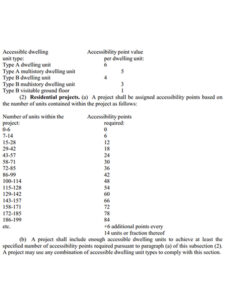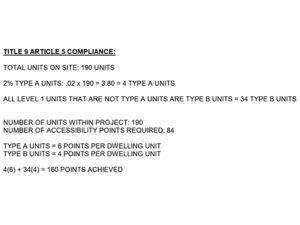
The International Building Code and Colorado State Statute Title 9 Article 5 both have requirements for unit accessibility in multi-family housing projects in order to increase the quantity of accessible units available in the housing market with each new development built. One major aspect to be considered early in the site development process of a new project is site accessibility. Where will the accessible units be located? Where are accessible routes on site required? Building codes and state statutes require two types of accessible units, Type A and Type B, with the latter having less restrictive requirements. For more information on accessibility requirements, refer to this published blog by EVstudio https://evstudio.com/type-a-vs-type-b-in-residential-design/ and the ANSI standard: https://codes.iccsafe.org/content/icca117-12017
Section 1107.6.2.2.1 of the 2018 IBC requires that 2% of the units (or at least one unit) on site be Type A. (For the purposes of this article, occupancy R-2 is assumed.) Additionally, “Type A units shall be dispersed among the various classes of units.” (2018 IBC 1107.6.2.2.1). While this statement may be subjective, best practice is to provide Type A unit size and location mix that is representative of the project mix as a whole.
Additionally, where four or more residences are provided in a single structure, all residences are required to be Type B accessible (2018 IBC 1107.6.2.2.2). In multi-family developments where elevators are not provided, only levels that are accessible are required to provide Type B units. There are exceptions for sites with prohibitive grade where no accessible route to a building entrance may be provided; a civil designer can help determine if a site qualifies for the exceptions.
Colorado State Statute Title 9 Article 5 requires development compliance by using a point system for residential developments of attached housing providing seven more residences. The statute assigns a point value for each of five unit types. For the purposes of this article, only Type A (6 points) and Type B (4 points) are used. The remainder of the unit types apply to multi-story units, typical of a townhome development. Developments are assigned a value of points that must be achieved based on the number of residential units that the development provides. For more information on the State Statute, visit: http://leg.colorado.gov/sites/default/files/images/olls/crs2018-title-09.pdf

Typically, multi-family developments will provide 2% Type A units with all units on accessible floors providing Type B units per the IBC, and this likely also satisfy the point system requirements of Title 9. A recent EVstudio project compliance example:

What does this mean with regards to site accessibility?
Units that are either Type A or Type B accessible must be on an accessible route (designed in accordance with ICC/ANSI A117.1) from building entrances and to “those exterior and interior spaces and facilities that serve the units” (2018 IBC 1107.4). This could include parking assigned to the units, handicap parking spaces, Right of Way adjacent the site, and other buildings on site that provide amenities for residents. Some exceptions may apply on sites with restrictive grade; it is important to begin discussions with design professionals, local Planning and Zoning Departments, as well as the Authority Having Jurisdiction as early as possible in the site planning process to determine accessibility requirements.










